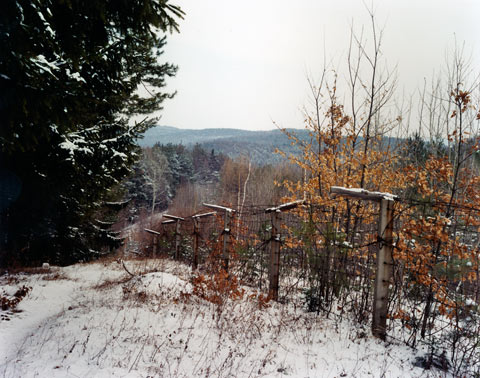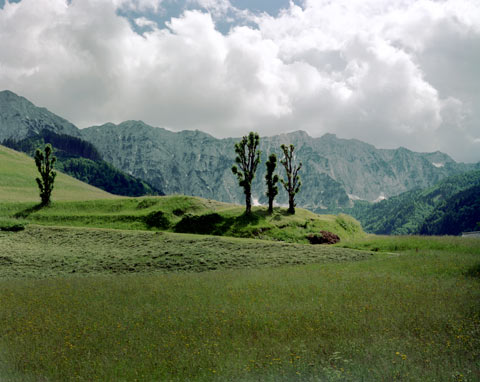New York/NYT Article

Barbed wire fence along the Austrian/Hungarian border, 1987 (4x5 film)
There was an interesting article in today's New York Times about former East Germans who attempted to escape the communist state of the German Democratic Republic (GDR) by a circuitous, and dangerous, route through Bulgaria. For those of you unfamiliar with the Iron Curtain, it was a mostly fortified border separating east and west that stretched all the way across Europe. In my Lost Border project I followed the borderline from the Baltic Sea in the north to the Adriatic in the south. That meant that I defined the Iron Curtain as running along the eastern edge of Yugoslavia where it touched Austria and Italy. Technically, Yugoslavia was not a part of the Soviet Bloc, but in practice, it was a communist country allied with the east.
I could have included the border separating Bulgaria from Greece and Turkey as well as the line between Finland and the Soviet Union. Rather than travel hundreds of miles of Finnish forest or trek through the mountains of the Bulgarian frontier, I chose to limit my project to the continuous line dividing continental Europe.
The reason that East Germans entertained the idea of fleeing across the Bulgarian border was that it was not fenced, or walled like it was in Germany, Czechoslovakia, and Hungary. While East Germans could not travel to the west, they could move about more or less freely in East Bloc countries. Many believed that the southern border offered a comparatively easy dash to freedom across open, though rugged, landscape. In reality, the border was heavily patrolled, and guards routinely shot to kill.
The Times article is based on the work of researcher, Stefan Appelius, a professor of political science at Oldenburg University, who estimates that some 100 East Germans were killed attempting to escape across the Bulgarian border. The article focuses on a couple, Olaf and Barbara Hetze, who made the attempt, unsuccessfully. They survived--she was shot, and he arrested--but eventually the West German government bought their freedom in an arrangement used frequently by the German Democratic Republic to procure western currency.

Mountainous terrain of the Austrian/Yugoslav border, 1985 (4x5 film)
Likewise, there were many attempted escapes by East Germans along the Czech, Hungarian, and Yugoslav borders. Only the Yugoslav border was unfenced, but its mountainous terrain and attentive border guards made flight near impossible. In fact, while making one of several border trips with my camera, I read in a local paper of an escapee who had been fatally shot by a Yugoslav guard, despite reaching Austrian soil. Such incidents occurred with some regularity contributing to the always tense atmosphere along the frontier, not to mention feeding international tensions between east and west.
The article is somewhat confusing in that it reads as if one had only the choice of escaping over the Berlin Wall or finding a way to run for it in Bulgaria. The Iron Curtain extended thousands of miles across Europe tracing a course through fields, forests, mountains, and even splitting villages. Escape was difficult everywhere, though, perhaps, easier in some places than others. I even recall hearing, or reading, about two men who escaped from East Berlin by traveling all the way to China where they were smuggled to the west by Canadian diplomats. They ended up in West Berlin only a few meters away from where they started.

0 Comments:
Post a Comment
Links to this post:
Create a Link
<< Home